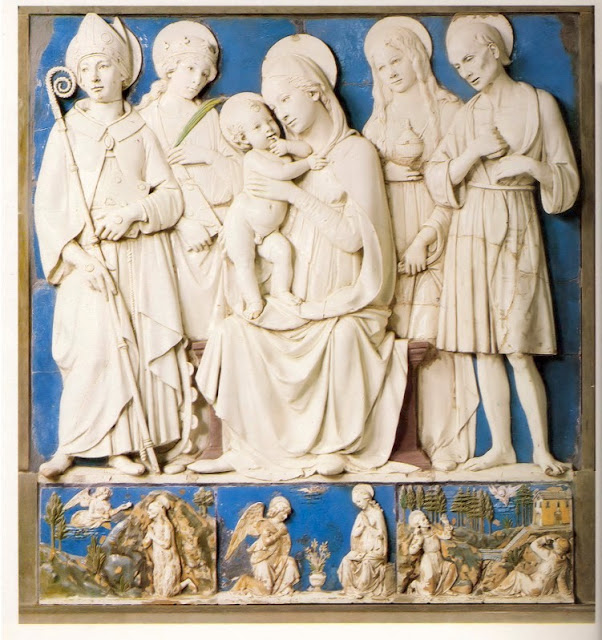 |
| Madonna and Child with Ss. Stephen and Lawrence, ca. 1489, Duomo of Prato |
The style of these works is quite distinctive. Sometimes the figures were coloured, but frequently they were monochromatic and set onto a royal blue background. Many of these works, especially his smaller, devotional works, were frequently accompanied by borders made up from decorative garlands with fruits and flowers.
Andrea della Robbia's works can be found throughout Tuscany, most notably in Florence, Arezzo, Siena, Lucca, Pistoia, Prato and Volterra, to name only a few, and while he also created fully three dimensional sculptural works in addition to his relief works, our focus for today are some of his iconic relief works -- works which predominate his portfolio. In view of that goal, LAJ is pleased to present today a brief survey of just some of his prodigious output as a sacred artist. Enjoy.
 |
| Madonna and Child with Ss. Peter and Paul, ca. 1510-1524 |
 |
| Madonna and Child with Ss. Cosmas and Damian, 1466, Arciconfraternità della Misericordia, Florence |
 |
| Pentecost, ca. 1505-1510 |
 |
| Madonna and Child, 1475 |
 |
| Annunciation, ca. 1490-1510 |
 |
| Assumption of the Virgin, ca. 1514 |
 |
| Crucifixion, Sanctuary of La Verna -- an example of a partially coloured corpus |
 |
| Madonna and Child with Angels, Louvre Museum |
 |
| Altarpiece of the Holy Trinity, 1485-1486, Cathedral of Arezzo |
 |
| Madonna of Mercy, ca. 1500-1510 |
 |
| St. Augustine, ca. 1490 |
 |
| Coronation of the Virgin, ca. 1474, Chiesa dell'Osservanza, Siena |
 |
| Madonna and Child with Angels, ca. 1505, Cathedral of Pistoia |
 |
| Aumbry, 1512, Santi Apostoli, Florence |
 |
| Madonna and Child, ca. 1505-1510, Hermitage |
 |
| Madonna and Child with Ss. Jerome, Catherine, Mary Magdalene and Louis, 1480 |
 |
| Detail of altarpiece of the Crucifixion and God the Father, ca. 1483 |
 |
| St. Lawrence, second half of the 15th century, Lucca |
 |
| ca. 1485-1490, Siena |
 |
| Nativity with St. John the Evangelist and St Francis of Assisi |
 |
| Madonna and Child, ca. 1470-1480, Florence |
 |
| Medallion of St. John the Evangelist, ca. 1491 |
















